Heading out the door? Read this article on the new Outside+ app available now on iOS devices for members! Download the app.
If you’ve never tried it, we’re here to tell you that sleeping outside in the winter is way more fun than it sounds. That’s thanks to huge advancements in tech and design that make today’s winter bags more like portable sleep spas than down survival sacks. We tested 17 different cold-weather cacoons to find the warmest, most breathable, comfortable, and packable options on the market. These seven bags put our testers into deep hibernation, even when temps dropped below zero. The challenge was waking up the next morning to face the cold.
At a Glance
- Best for Extreme Cold: Marmot CWM -40 ($929)
- Best Value: Cumulus Teneqa 1000 (-2 F) ($555)
- Best Warmth-to-Weight Ratio: Sea to Summit Spark (0F) ($487)
- Lightest: Thermarest Parsec 0F ($639)
- Best Expedition Workhorse: Thermarest Polar Ranger -20F ($665)
- Best for Variable Temps: NEMO Sonic 0F Down ($600, Regular)
- Best Winter Mountaineering Bag: Feathered Friends Widgeon ES (-10) ($889)
- How to Choose a Winter Sleeping Bag
- How We Test
- Meet Our Testers
If you buy through our links, we may earn an affiliate commission. This supports our mission to get more people active and outside. Learn more.
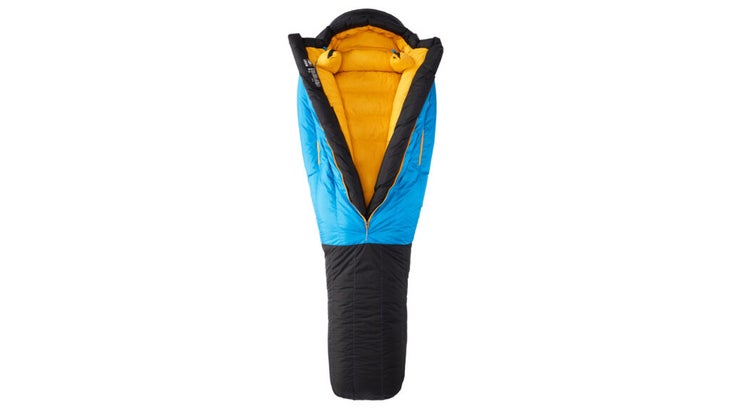
Best for Extreme Cold
Marmot CWM -40
$929 at Backcountry $949 at Marmot
Weight: 5 lbs (Regular)
Sizes: Regular, Long
Pros and Cons
⊕ Warm down to -40
⊕ Tough exterior fabric
⊕ Side zippers for arms
⊗ Overkill for the Lower 48
⊗ Heavy
“There is a lot to love about this -40-degree bag, one being that it will keep you warm in -40,” says Alaskan dog musher, guide, and snowboarder Jody June Potts. That means something coming from Potts, who is indigenous to Alaska’s Upper Yukon River country and has appeared in the National Geographic television series “Life Below Zero: First Alaskans.” She spends much of her winter outside in sub-zero temperatures that can quickly kill her if she is not prepared with the right gear.
To test the 800-fill-power goose down bag, Potts took it on a dogsledding overnight along the Yukon River during crystal clear, -30-degree weather. Instead of sleeping in a tent, Potts bedded down in her sled. The CWM is suitable for open-air camping thanks to a tough exterior 30-denier nylon fabric (the highest-denier of all the bags we tested) with a windproof, waterproof, breathable Pertex membrane. Potts reported the down was well-distributed throughout the vertically-baffled bag, with no hot or cold spots. For extra warmth in the feet, the mummy has a multi-baffled wraparound foot box, and to keep the head cozy, it’s equipped with a secondary internal hood and draft collar that can be cinched tight to prevent heat loss. Snuggled in, Potts was comfortable even in dangerously cold conditions.
While most appreciative of the fact that the bag kept her alive, Potts was also duly impressed with the “multiple thoughtful features that make life easier when camping in extreme winter conditions.” The most salient is a center-zip that ends right below the waist with dual side zippers for the arms that allowed her to sit up and perform tasks without leaving the CWM while also providing additional venting in warmer weather. The zipper operated easily without snagging on fabric and the zipper pull was big enough so that she could use it even while wearing heavy mitts—critical at these temps when every second matters.
One interior zip and two interior mesh pockets kept Potts’ emergency items, phone, and batteries warm. While the bag weighs at least a half-pound more than comparable -40 bags, it’s worth its weight in gold when it comes to warmth. It also comes with a functional compression sack that squeezes the bag down to the size of a small grocery tote.
Says Potts: “This bag is pretty dang perfect. It’s a mummy I can depend on to stay warm if I find myself in a bad situation overnight in the wilderness.”
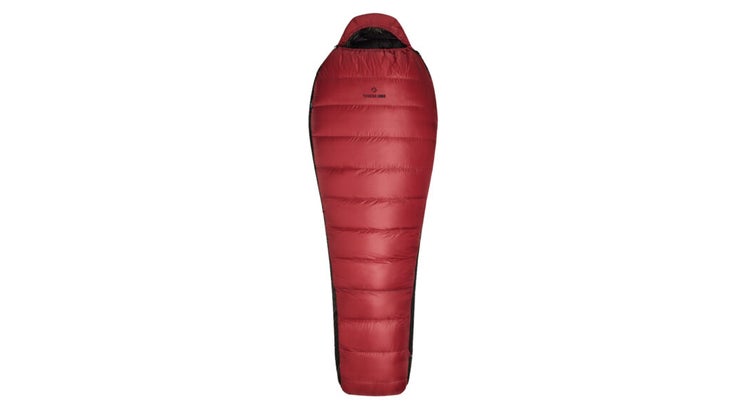
Best Value
Cumulus Teneqa 1000 (-2 F)
Weight: 3 lbs, 5 oz
Sizes: Regular (customizable with a right or left zipper)
Pros and Cons
⊕ Affordable
⊕ Roomy fit
⊕ Quick-drying
⊗ Sticky zipper
⊗ Fussy hood cinch
Veteran gear tester Dorn Van Dommelen ranks the Teneqa 1000 in the top three zero-degree bags he’s ever slept in. During a March three-night trip to Alaska’s Chugach State Park, he camped in deep snow with strong alpine winds and temps in the teens, and found the 850-fill-power goose down bag from Polish manufacturer Cumulus to be quick-lofting and cozy. It’s easy to pack, too compressing down to the size of a small watermelon.
Full-length vertical baffles maximized warmth on each side, smaller horizontal chambers on the front and back minimized cold spots, and two down tubes protected drafts along the zipper. Anatomical features like a slightly wider fit in the chest and a “shark fin” footbox that flares at the top so that the toes don’t put tension on the fabric made the bag feel roomy.
Van Dommelen reported that the water repellent Pertex Quantum 15-denier ripstop shell fabric was so breathable that it dried out over the course of the day, despite damp conditions and overnight condensation.
Most importantly, it’s $150 cheaper than comparable zero-degree bags. Despite disappointment with the fussiness of the hood cinch and a few sticky zippers, “this is a great all-around bag,” Van Dommelen reported. “It kept me entirely warm every night.”
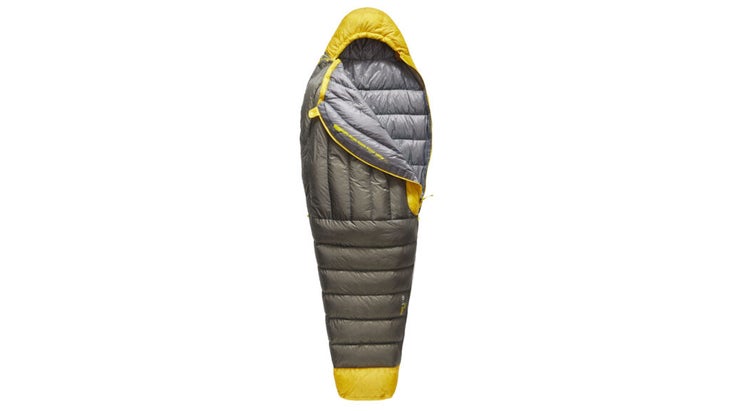
Best Warmth-to-Weight Ratio
Sea to Summit Spark (0F)
$487 at REI (Regular) $649 at Sea to Summit (Regular)
Weight: 2 lbs, 7 oz
Sizes: Regular, Long
Pros and Cons
⊕ Packable
⊕ Lightweight
⊕ Sheds moisture
⊗ Thin insulation in footbed
⊗ Tight for some builds
“Simple and straightforward” is how tester Hansi Johnson’s summed up the Spark 0, an ultralight 850-fill-power goose down mummy that packs down to the size of a puffy jacket.
Despite a 10-degree low, raging wind, and drifting snow while pitched on a frozen lake in Minnesota’s Superior National Forest, Johnson stayed perfectly comfortable through the night. The plump vertical down baffles throughout the torso and horizontal baffles along the legs kept him warm and dry, thanks to a water repellent down treatment.“The baffles were in all the right places and I felt almost no drafts or gaps.”
For additional protection from soggy sleeping, the down is sandwiched under a 10-denier nylon shell treated with a durable water-repellent finish. “The bag easily shed the spin drift and was not in the least bit wet or damp despite having snow on it in the morning,” reported Johnson.
At 6’1,” Johnson maxed out the space his Regular bag, but it still felt roomy, especially in the shoulders, which have a slightly larger 61-inch circumference than many regular-sized bags: “I had to squeeze in, but once I was inside, never felt restrained.”
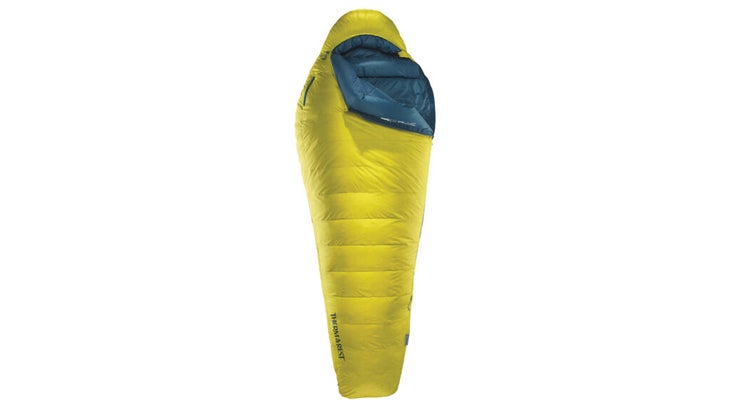
Lightest
Therm-a-Rest Parsec 0F
$620 at REI (Long, 2024 version) $570 at Therm-a-Rest (available January 2025)
Weight: 2 lbs, 6 oz
Sizes: Small, Regular, Long
Pros and Cons
⊕ Very lightweight
⊕ Packs down small
⊕ Sheds water
⊕ Very breathable
⊕ Comfortable for side sleepers
⊗ Catchy zipper
The 800-fill-power Parsec 0F was the lightest in test, and compressed down to the size of a large paper towel roll. It was a no-brainer for northern Minnesota cyclist Patrick Greehan to take on seven variable-length bikepacking adventures in February, when nighttime temps ranged from six to 30 degrees.
One concern Greehan had before sleeping in the bag was that the roomy hood looked too drafty, but the cinchable collar and draft tubes kept his head warm enough while the extra space made the mummy especially comfortable for side sleepers.
Thanks to a 20-denier, DWR-treated lining and hydrophobic-treated down, Greehan was stoked on how warm and dry the lightweight bag kept him even on a night with high humidity, warm temps, and snow, a combo that brought both frost and condensation. “I had lots of both,” reported Greehan, “but the shell and hydrophobic down delivered as promised.” He added that the extra baffled pocket of down insulation in the footbed to keep his feet warm all night.
The Parsec’s removable, lightweight pad straps kept the mummy secure on Greehan’s pad and one external zip pocket on the chest secured his phone. “A zero degree bag’s ultimate job is to provide comfortable sleep in single digit temps, and this delivered,” concluded Greehan.
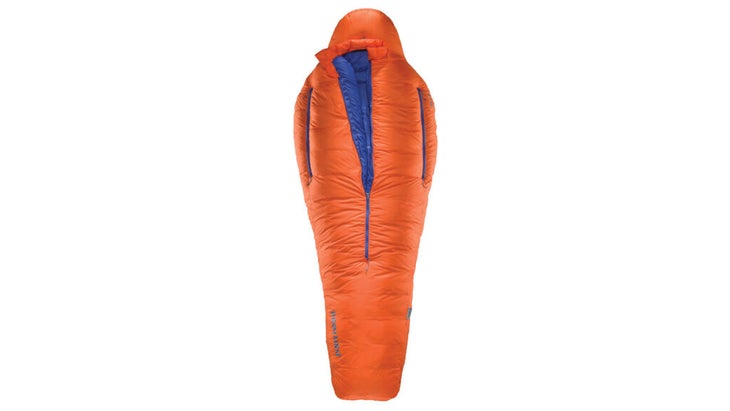
Best Expedition Workhorse
Therm-a-Rest Polar Ranger -20F
$665 at Amazon (2024 version) $790 at Therm-a-Rest (available January 2025)
Weight: 3 lb, 4 oz. (Regular)
Sizes: Regular, Long
Pros and Cons
⊕ Side zips for venting
⊕ Dries quickly
⊕ Holds loft well
⊗ Hard to quickly exit
⊗ Hard-to-find interior pocket
The Polar Ranger was one of the best expedition bags on the market when it came out in 2018 thanks to polar explorer Eric Larson, who helped design the mummy for the specialized environment. The result was a pioneering three-quarter length zipper straight up the middle to cut weight and increase warmth. Zippered side vents made it possible not only to dump heat, but also sit up, shoot your arms out, and do anything from write in a journal to fiddle with a sat phone. “In an expedition situation, every ounce of energy saved is key,” Larson explained over email. “After spending years of my life in a sleeping bag, I found full length zippers unnecessary in most situations.”
But the Polar Ranger wasn’t without its imperfections. The newest iteration comes with a slew of upgrades that make the bag even more livable. A fresh, 100-percent recycled DWR-coated nylon ripstop shell and a buttery-smooth 100-percent recycled nylon liner are silky to the touch. The newer version is also slightly larger in both length and girth after feedback from the field that the bag was too tight with heavy winter layers on. A redesigned snorkel hood is stiffer and shorter, too, which means improved breathing and ventilation, with a magnetic closure that makes it easy to break free in case of a claustrophobia emergency. Small but critical details? An added internal drawcord in the draft collar for cinching the bag around the neck and shoulders, and an internal pocket for keeping small electronics warm.
Our testers found the 800-fill-power hydrophobic down bag up to the task of keeping them warm on -10 degree overnights with lots of wind in Minnesota’s Boundary Waters Canoe Area Wilderness. “I used the arm holes way more than I thought I would,” reported Minnesota-based tester Hansi Johnson who, as a side sleeper, was also impressed with the roominess of the bag and how it maintained its loft on all sides as well as on the back. The snorkel hood, on the other hand, took a little getting used to. “It felt claustrophobic at first, but it kept moisture off my face. I was so warm I tossed my Buff.”
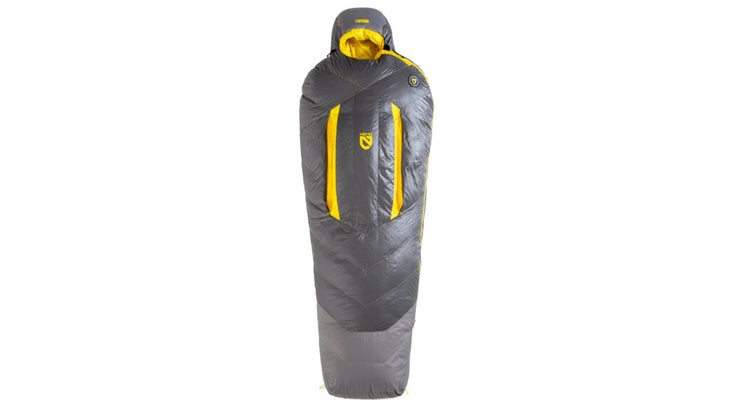
Best for Variable Temps
Nemo Sonic 0F Down
$600 at Backcountry $600 at Amazon
Weight: 3 lb, 4 oz (Regular)
Sizes: Short, Regular, Long
Pros and Cons
⊕ Great temperature regulation
⊕ Relatively sustainable
⊗ Small top vent zipper pulls
⊗ Tiny exterior pocket
NEMO gave the Sonic a significant upgrade in 2023, improving its ability to adjust to varying temperatures, giving it greater warmth retention, and making it more sustainable. And we’re happy to report that it’s still one of the best bags on the market. Over three campouts, nestled in a bivvy sack atop multiple feet of packed snow in northern Minnesota, with temperatures that ranged from three to 20 degrees Fahrenheit, tester Pat Greehan slept like a baby.
The most notable upgrade for Greehan was the bag’s redesigned “Thermo Gills,” the two vents on top of the bag that can be opened or closed to regulate body temperature. The improved gills, which run vertically down the top half of the bag, now have internal and external zippers that work independently of each other to more finely tune ventilation and comfort. On the 20-degree nights when he fully unzipped, Greehan was able to prevent himself from overheating. On the three-degree nights, he remained in that same comfort zone by zipping them back up.
To improve warmth retention, NEMO redesigned the draft tube along the side zipper and added a velcro tab to the draft collar to keep cold air from sneaking in. New, chevron-shaped baffles hold the 800-fill power hydrophobic down in place and provide more uniform lofting. As a back and side sleeper, Greehan was able to snooze in both positions with no cold spots. A layer of synthetic insulation in the toebox protected the down from wetting out, a common occurrence at the bottom of a bag.
To complete the overhaul, NEMO updated the shell and liner fabrics, using plush, 100-percent recycled, bluesign-approved nylon for the shell and a silky, 100-percent recycled polyester for the liner.
Other exceptional features? The roominess of the hood—which Greeham could cinch tightly if needed—the bag’s excellent packability (it scrunches down to an XXL roll of paper towels despite an only average weight) and a robust zipper that never got caught up on the lining.
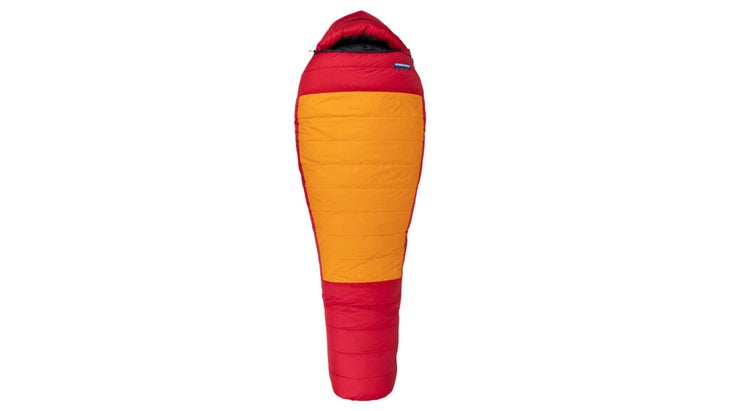
Best Winter Mountaineering Bag
Feathered Friends Widgeon ES (-10)
Weight: 3 lb, 5 oz (Regular)
Sizes: Regular, Long
Pros and Cons
⊕ Extremely warm and comfortable
⊕ Packable for temp rating
⊗ Narrow footbox
⊗ Pertex layer is loud
The Widgeon cocooned our testers in so much warmth and silky comfort that they could have happily hibernated all day. Already a frigid-weather favorite, the handmade-in-Seattle bag—originally designed for a K2 expedition back in the ’80s—received a major facelift in recent years. Feathered Friends added three additional ounces of responsibly-sourced 900-fill power goose-down. That down is sandwiched between a gossamer 20-denier nylon Pertex taffeta lining made from PFC-free recycled yarns and a water-resistant, breathable Pertex nylon shell with a DWR coating. The collar and hood keep your face snug, warm, and protected (but not claustrophobic) thanks to a gradually contoured cut. It can be cinched nearly all the way closed using a nylon cord that runs around the perimeter of the top of the bag.
With all that plush comfort, one might think the bag would sleep too hot. But even when camping in late March, I never overheated while cowboy camping in northern Minnesota in temps that ranged from 15 to 28 degrees—balmy compared to its negative ten degree rating. The reason? An additional Pertex nylon panel over the top of the bag vastly improves its breathability and venting. That Pertex layer blocks moisture, too: Despite waking up to a thick layer of hoar frost, I stayed dry in my bag.
Additional small-but-mighty upgrades include a second sidewall to ensure even insulation all around the circumference of the bag; more streamlined internal construction that cuts weight despite the extra down, and a generous draft tube to stop cold air from seeping through the zipper. That might sound like splitting hairs, but every warmth-preserving measure matters when you’re winter camping—especially on the flanks of K2. And, for a bag so lofty, it packs down impressively to the size of a 64-ounce beer growler.
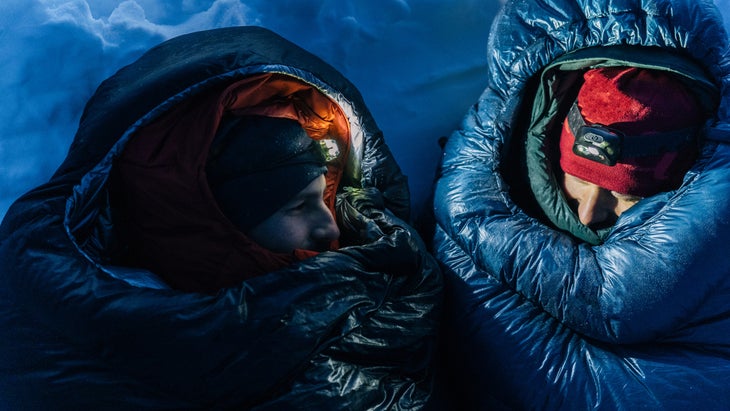
How to Choose a Winter Sleeping Bag
As a general rule, men tend to run hotter and women tend to run colder—although, as with anything, there is a spectrum. Throw in varying sleeping positions, body shapes, and sizes, and it’s quickly evident that while some bags offer superior materials and design, there’s not one magic winter bag that works for all. To find the one that will work best for you, here are four things to consider that keep you from investing a significant chunk of change in the wrong bag.
Intended Use
Are you purpose-buying the bag for a specific mission like Eric Larson’s 14-day Svalbard Expedition or to climb Denali? If so, you’ll need one with an excellent warmth-to-weight ratio that will be relatively easy to haul, yet keep you warm enough in potentially life-threatening situations. Or do you intend to use it on shorter missions like weekend ice-fishing jaunts into Minnesota’s Boundary Waters Canoe Area Wilderness? In that case, you’ll likely be hauling a sled and will have fewer size and weight restraints. Or maybe you need an ultralight bag for a winter bikepacking trip that you can strap to your handlebars and only use in case of an emergency. Whatever the reason for buying the bag, think through the logistics of the journey and how that will affect the size, weight, and warmth of the bag you want to buy.
Insulation
Down bags are generally warmer for their weight and more compressible than bags with synthetic insulation. But if down bags get wet, they lose insulating capacity and take longer to dry out than synthetic bags. Many manufacturers use down processed with a hydrophobic chemical that prevents it from absorbing as much water. Others keep the insulation dry with a water-repellant finish or fabric. Pay attention to fill power ratings, which range from about 600 to 900. In the test lab, that figure refers to the number of cubic inches one ounce of down consumes in a beaker. In practice, it means that compared to sleeping bags rated to the same temperature, yours will weigh less and pack down smaller than bags with a lower fill power. Synthetic bags are more affordable, and therefore an excellent choice for new campers who are unsure how often they want to sleep outside, or backpackers who are headed to wet environments.
Shape
Most winter bags are mummy bags or modified mummy bags. Traditional mummies have a hood that gently tapers into the bag, is wide at the shoulders and narrows all the way to the footbox. Mummies are great for winter because they minimize dead space inside the bag and help keep you warmer by giving air less space to circulate. Some people find them cozy and cocoon-like, others find them claustrophobic.
For claustrophobes, a modified mummy comes in handy. While it’s generally tapered like a mummy, it’s cut more loosely in certain areas. Some offer slightly flared footboxes to give your toes more room, while others are wider in the body to accommodate side sleeping. Some have hoods that gently taper into the bag, others have removal hoods.
Temperature Rating
All bags on the market have EN (European Norm) or ISO (International Standards Organization) ratings, which are standardized, independent tests across manufacturers. The most commonly used since 2017 is the ISO rating. Note: ISO stops rating at -20C/-4 F, which means your -20 degree bag may require a test run before you head into truly frigid conditions.
With these standards, most sleeping bag manufacturers use a sliding range of temperatures for which a bag can be used. The “Comfort Range” is roughly the temperature range at which the average female will remain warm. The “Lower Limit” is the temperature range at which the average male can remain comfortable. This Lower Limit number is the temperature rating of the bag. That being said, your temperature tolerance will depend on much more than your gender, so it’s always best to err on the conservative side. Some bags offer a “Risk” range, which indicates the lowest temperature in which the bag should be used. At this temperature, the bag might not prevent hypothermia, but it may prevent death. It’s always best to buy a bag rated ten degrees colder than the average temperatures you intend to use it in. For example, if you plan to camp in conditions no colder than 10 degrees, you’ll want a 0-degree bag.
How We Test
- Number of Testers: 9
- Number of Nights Slept Outside: 52
- Coldest Night: -40F in Alaska along the Yukon River
- Warmest Night: Upper 30s in an unheated cabin in northern Minnesota
- Highest Altitude: 10,000 feet at Grand Mesa National Forest, Colorado
- Highest Latitude: 64°47′10″N in Eagle, Alaska
To ensure that bags were tested in appropriate temperatures and altitudes, we distributed them across the country to frigid states including Alaska, Colorado, and Minnesota. We also cultivated a wide range of athletes, including dog mushers, backcountry skiers, bike packers, ice fishermen, and first-time winter campers.
We tested 20 bags over the course of four months, starting in mid-January and ending in mid-April. During that 120-day period, testers experienced a wild array of weather, from deep snow in Alaska’s Chugach State Park to freakishly low snow cover and mild temperatures in northern Minnesota. Testers used their bags while dog-mushing along the Yukon River, sleeping out on their decks while stargazing in sub-zero nights in Duluth, and camping out during winter bikepacking trips.
To collect feedback and rank her favorites, Category Manager Stephanie Pearson and her team of testers rated each bag on a number of independent qualities, including warmth, compressibility, loft, comfort, durability, water resistance, and extra features. The end result? Extremely well-tested bags that kept Backpacker‘s crew of testers alive and cozy.
Meet Our Testers
Sam Armacost is a Minnesota-based canoe guide and long-distance paddler, with over a decade of experience guiding trips into the Canadian wilderness and the Boundary Waters Canoe Area Wilderness. Her multi-month expeditions have taken her to the Arctic Ocean and the Gulf of Mexico.
Patrick Greehan is a coach for the Duluth Devo Mountain Bike Program. He currently races gravel, mountain, and fat bikes with a focus on long distance and ultra events. He is an avid bikepacker who takes trips year-round in Northern Minnesota.
Jody June Potts is indigenous to the Upper Yukon River country at Eagle, Alaska. She’s a dog musher, guide, snowboarder, and lover of all things winter.
Stephanie Pearson is the Nordic Skiing, Sleeping Bag, and Sleeping Pad Category Manager for Outside and Backpacker and is based in northern Minnesota. Her most uncomfortable winter night was in a wet snow cave in freakishly warm 30+ degrees while dogsledding along Lake Superior’s Apostle Islands National Lakeshore.
